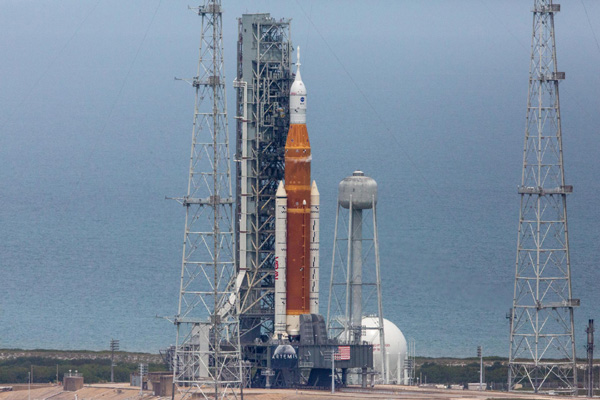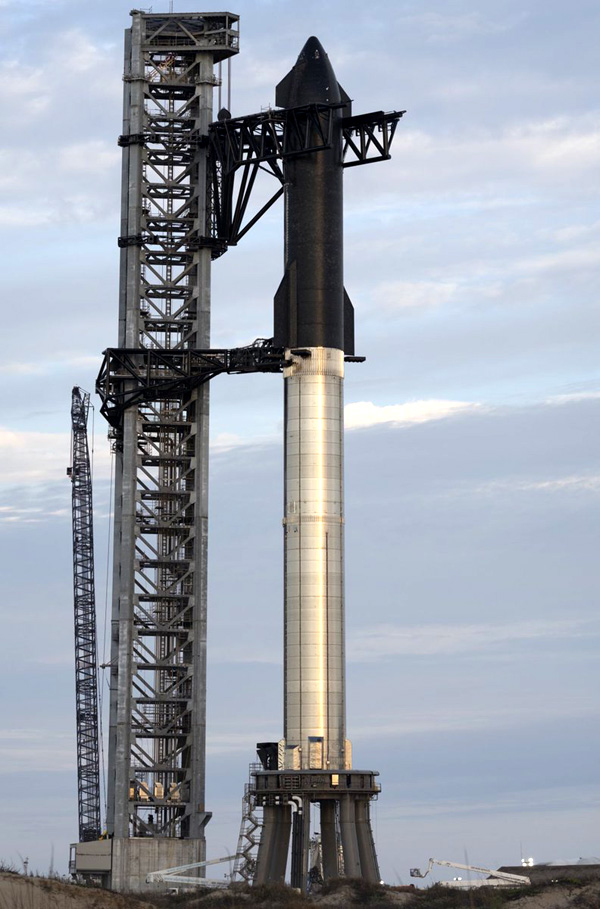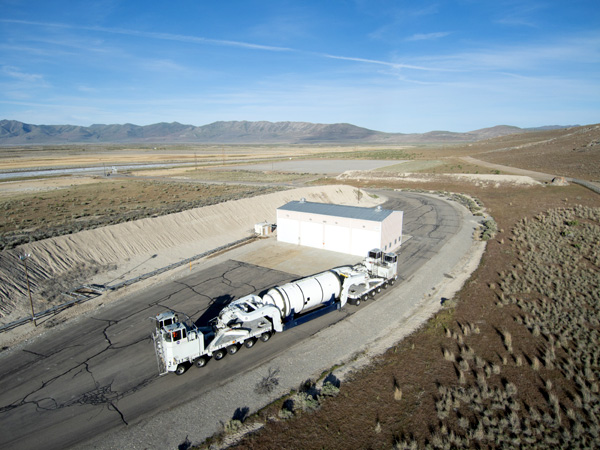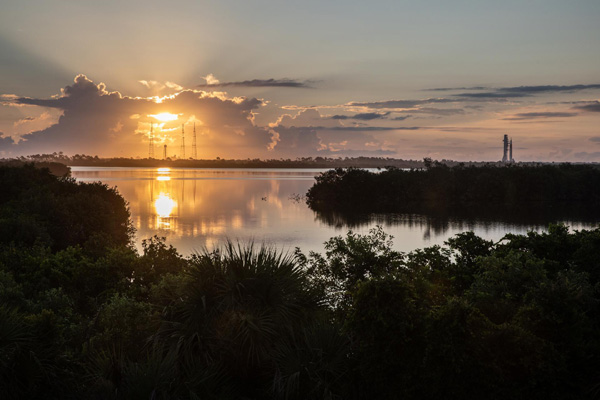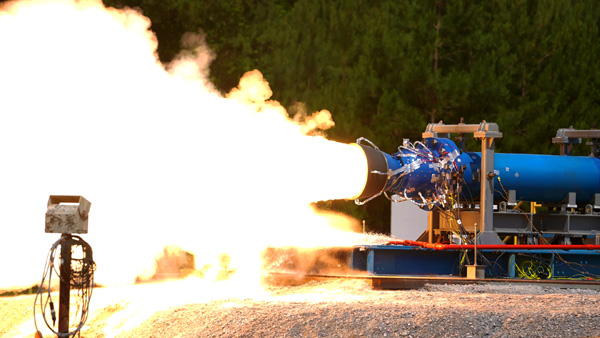 NASA Completes Wet Dress Rehearsal, Moves Forward Toward Launch (News Release)
NASA Completes Wet Dress Rehearsal, Moves Forward Toward Launch (News Release)
NASA has analyzed the data from the
wet dress rehearsal conducted Monday, June 20, and determined the testing campaign is complete. The agency will roll
Space Launch System (SLS) and
Orion back to the Vehicle Assembly Building
(VAB) at Kennedy next week to prepare the rocket and spacecraft for launch.
"During the wet dress rehearsal activities, we have incrementally added to our knowledge about how the rocket and the ground systems work together, and our teams have become proficient in launch procedures across multiple sites. We have completed the rehearsal phase, and everything we've learned will help improve our ability to lift off during the target launch window,” said Tom Whitmeyer, deputy associate administrator for common exploration systems at NASA Headquarters. “The team is now ready to take the next step and prepare for launch.”
During Monday’s rehearsal, teams were able to validate the timelines and procedures for launch, including loading cryogenic – or supercold – propellant into the rocket’s tanks, performing the launch countdown through the handover to the automated launch sequencer, and draining the tanks. The rehearsal focused on two primary objectives and several secondary objectives to help ensure the team will be ready to launch on the
Artemis I flight test.
The primary objectives were:
- Demonstrate cryogenic loading operations through all phases of propellant loading and proceed into terminal countdown, perform a recycle to T-10 minutes, a second terminal countdown, scrub, and perform propellant drain operations and safing activities
- Demonstrate Kennedy facilities Launch Complex 39B and Launch Control Center in launch countdown configuration and demonstrate operations and connectivity required on day of launch with launch control team, support launch team, 45th Delta Space Force Eastern range, network, and design center support
Secondary test objectives include:
- Demonstrate successful Kennedy Launch Control Center interfaces with the Marshall SLS Engineering Support Center, Delta Operations Center of the 45th Space Force, and Johnson Flight Control and Mission Evaluation Room including communications, operational television for monitoring the rocket and spacecraft, and telemetry in launch day configuration
- Collect data on Orion, SLS and mobile launcher launch configuration loads, cryogenic-induced deflection and thermal data during cryogenic load and drain, as well as imagery of vehicle performance
- Validate the timelines/procedures for rollout and rollback, launch countdown, launch window including time to complete a recycle and set-up for next T-0
- Collect data on electromagnetic interference and compatibility with vehicle and 45th Delta Space Force Eastern range systems configured for launch day during planned flight termination system testing
- Assemble and stage Red Crew, Fire Rescue Crews, Medical and other supporting launch teams
By reaching deep into the final phase of the countdown, known as the terminal count when many critical activities occur in rapid succession, teams exercised all the assets and capabilities of the entire system: the SLS rocket, the Orion spacecraft, and Exploration Ground Systems including at Launch Complex 39B and other supporting locations.
Despite a liquid hydrogen leak detected earlier in the day when increasing pressure to condition the engines, teams were able to develop a plan to proceed into the terminal count with the expectation the countdown would stop after handover to the flight software for the automated launch sequencer. The software performs checks to confirm the engine temperatures are within acceptable range up to the point of the engine start sequence at T-9.34 seconds and operated correctly to halt the countdown at any point if temperatures fall outside that range, just as it would during an actual launch attempt.
"The team continues to impress me with their creative thinking and resourcefulness,” said Charlie Blackwell-Thompson,
Artemis launch director at Kennedy. “Our Artemis launch team has worked quickly to adapt to the dynamics of propellant-loading operations. With each milestone and each test, we are another step closer to launch."
The launch director elected to do a single run through the terminal count due to the length of the day for the launch teams. With experience from loading operations and simulations, it is not necessary to perform a retest to demonstrate the ability to recycle and reset for another run through the terminal count. Additionally, as part of the normal procedures after the cut-off of the countdown, teams successfully completed a set of steps to “safe,” or stabilize and reconfigure, the rocket.
Engineers reviewed the few commands that would have been included within the remaining seconds of the countdown before the engine start sequence and determined those activities had been previously validated in other recent tests. The remaining commands were not part of the objectives, but the team has decided to incorporate additional checks earlier in the countdown as they fine-tune procedures, such as for engine purge bleed parameters and propellant feedline heaters used for conditioning the engines to a specific temperature range for launch. Performing these checkouts earlier in the countdown will provide the team with the best position to make the target launch window.
Before returning to the VAB, engineers will also add a checkout of the booster hydraulic power unit to provide additional data for the countdown schedule. The units contain hydrazine-powered turbines attached to pumps that provide pressure to pivot the booster nozzles used for steering the rocket during ascent. The automated launch sequencer sends the command to start the hydraulic power unit at T-28 seconds, which would have occurred just after the point the flight software cut off the countdown at T-29 seconds.
Once inside the VAB, teams will replace a seal on the quick disconnect of the tail service mast umbilical to address a liquid hydrogen leak detected during the rehearsal. NASA plans to return SLS and Orion to the pad for launch in late August, and will set a specific target launch date after replacing hardware associated with the leak.
Artemis I will be the first integrated test of NASA’s deep space exploration systems: the Orion spacecraft, SLS rocket and supporting ground systems. As the first in a series of increasingly complex missions, Artemis I will pave the way for long-term exploration at the Moon in preparation for human missions to Mars.
Source: NASA.Gov
****
 NASA
NASA






